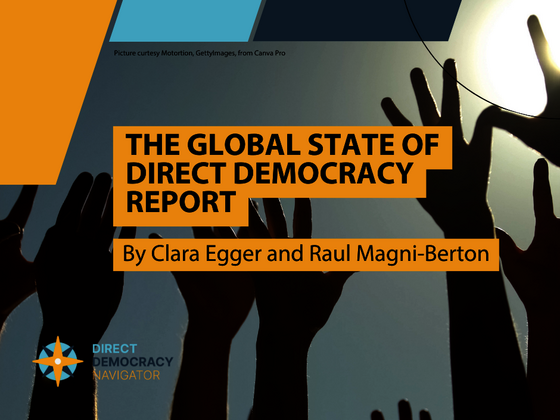Global State of Direct Democracy Report 2024
The Global State of Direct Democracy Report by Clara Egger and Raul Magni Berton gathers legal provisions, held referendums, short-term trends in the use of direct democracy institutions, reforms and academic publications. The Report provides comments to create a comprehensive picture of the current state of direct democracy.
You can read the Global State of Direct Democracy Report here.
Direct democracy: Measurements, databases, and glossary
This first part presents the Direct Democracy Navigator, but also several other sources of information on the legal mechanisms of direct democracy around the world and their effective use. It helps to navigate through the different definitions of direct democracy and the different names used to refer to the different institutional components of this concept (such as popular initiatives, direct initiatives, citizens' initiatives, etc.). The section concludes with a glossary of terms used in this report.
Direct democracy: from principles to practice
This second part offers a comprehensive description of what is expected from direct democracy and how this expectation is more or less embodied in concrete legal institutions. In particular, we focus our analysis on the extension of the right of initiative and the right of veto to the entire citizenry. Based on this normative purpose, we offer a typology that distinguishes between institutions that offer hard, soft, and no initiative and veto rights, on the one hand, and the degree of accessibility of these rights, on the other.
Institutions of direct democracy and their development around the world
The third part analyzed political systems around the world in terms of their openness to direct democratic institutions. Based mainly on the Navigator to Direct Democracy, this chapter also shows how difficult it is to categorize specific institutions because details can sometimes make big differences. After this broad overview, we offer a ranking of existing political systems that offer citizens more control over their own legislation.
Popular votes in perspective: recent trends in voting activity
The fourth part analyzes recent practices of direct democracy in the world. It identifies the countries in which citizens vote more and which instruments are mainly used to open the legislature to citizens. The practice of direct democracy at national and local level during the last 5 years allows the reader to compare the expected power of legal systems with their actual use.
Popular votes in 2023
This report will be published annually, and an assessment is made of referendums and constitutional reforms that take place in 2023. The details of these events are useful to identify the countries where direct democracy could develop in the near future or, on the contrary, the places where direct democracy is backsliding. Data on referendums are provided by the main database on this issue, the Referendum Database (RDB). This part is also an opportunity to analyze some missing important events, such as the constitutional referendum in Chile.
Latest scientific evidence on direct democracy
Beyond its actual use, the scholarly literature on direct democracy is growing every year, offering new evidence and insights. This sixth part covers the 2023 scholarly debates and publications on direct democracy, mainly in English, to better document the latest news on our normative and positive understanding of this topic.
Developments to follow in 2024
This last part is the conclusion. It summarizes the main findings of the report and offers some ideas about the near future of direct democracy, both for its institutional development and for its actual practice.


